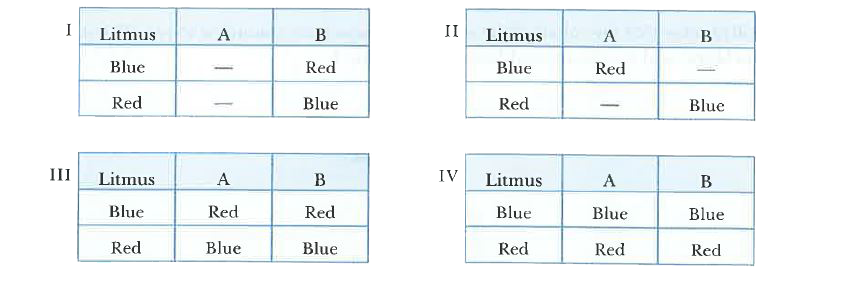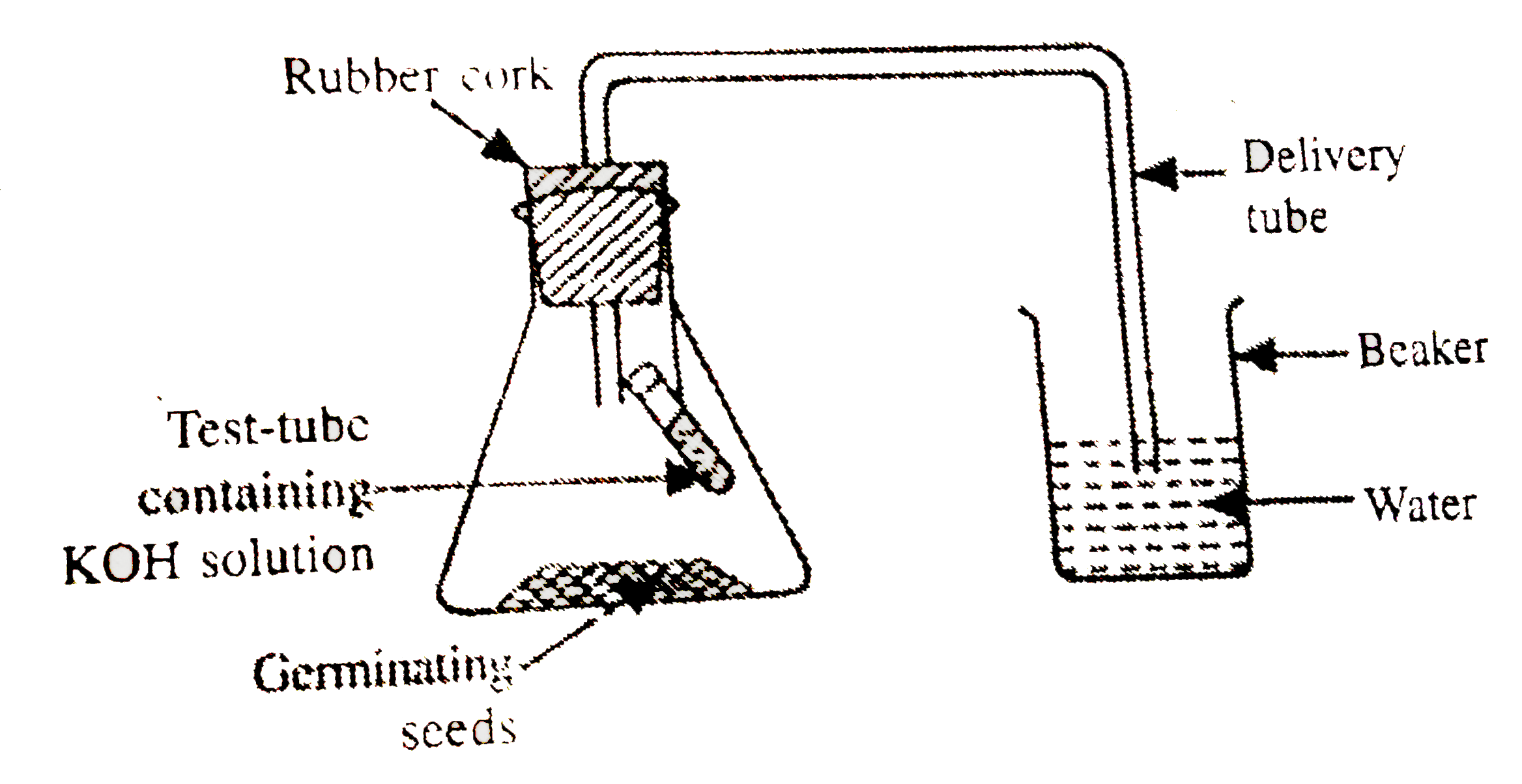When four dilute solutons of (1) vinegar, (II) common salt, (III) caustic soda and (IV) baking soda are tested with universal indicator which will be the correct observation.
I- Green, II- Violet, III- Blue, IV-Red
I- Green, II- Blue, Ill-Violet, IV-Red
I- Red, II- Green, III- Violet, IV- Blue
I- Red, II- Violet, III- Green, IV- Blue
The correct Answer is:C
To determine the correct observations when testing the four dilute solutions (vinegar, common salt, caustic soda, and baking soda) with a universal indicator, we can follow these steps:
1. Identify the Nature of Each Solution:
- Vinegar: This is an acidic solution (acetic acid).
- Common Salt (Sodium Chloride): This is a neutral solution.
- Caustic Soda (Sodium Hydroxide): This is a basic (alkaline) solution.
- Baking Soda (Sodium Bicarbonate): This is also a basic (alkaline) solution.
2. Understanding Universal Indicator:
- A universal indicator is a pH indicator that changes color based on the acidity or alkalinity of the solution.
- It typically shows red or orange for acidic solutions, green for neutral solutions, and blue or purple for basic solutions.
3. Testing Each Solution:
- Vinegar: When tested with the universal indicator, it will turn red or orange, indicating it is acidic.
- Common Salt: When tested, it will show green, indicating it is neutral.
- Caustic Soda: When tested, it will turn blue or purple, indicating it is basic.
- Baking Soda: When tested, it will also turn blue or purple, indicating it is basic.
4. Summarizing the Observations:
- Vinegar: Red/Orange (Acidic)
- Common Salt: Green (Neutral)
- Caustic Soda: Blue/Purple (Basic)
- Baking Soda: Blue/Purple (Basic)
Final Observations:
- Vinegar: Acidic (Red/Orange)
- Common Salt: Neutral (Green)
- Caustic Soda: Basic (Blue/Purple)
- Baking Soda: Basic (Blue/Purple)
- Vinegar: This is an acidic solution (acetic acid).
- Common Salt (Sodium Chloride): This is a neutral solution.
- Caustic Soda (Sodium Hydroxide): This is a basic (alkaline) solution.
- Baking Soda (Sodium Bicarbonate): This is also a basic (alkaline) solution.
- A universal indicator is a pH indicator that changes color based on the acidity or alkalinity of the solution.
- It typically shows red or orange for acidic solutions, green for neutral solutions, and blue or purple for basic solutions.
- Vinegar: When tested with the universal indicator, it will turn red or orange, indicating it is acidic.
- Common Salt: When tested, it will show green, indicating it is neutral.
- Caustic Soda: When tested, it will turn blue or purple, indicating it is basic.
- Baking Soda: When tested, it will also turn blue or purple, indicating it is basic.
- Vinegar: Red/Orange (Acidic)
- Common Salt: Green (Neutral)
- Caustic Soda: Blue/Purple (Basic)
- Baking Soda: Blue/Purple (Basic)
- Vinegar: Acidic (Red/Orange)
- Common Salt: Neutral (Green)
- Caustic Soda: Basic (Blue/Purple)
- Baking Soda: Basic (Blue/Purple)
Topper's Solved these Questions
- OLYMPIAD 2019 - 20Book:OSWAL PUBLICATIONChapter:OLYMPIAD 2019 - 20Exercise:CHEMISTRY QUESTIONS (Carbon and its Compounds )
Explore 3 Videos
- OLYMPIAD 2019 - 20Book:OSWAL PUBLICATIONChapter:OLYMPIAD 2019 - 20Exercise:CHEMISTRY QUESTIONS (Matter in our Surroundings )
Explore 2 Videos
- OLYMPIAD 2019 - 20Book:OSWAL PUBLICATIONChapter:OLYMPIAD 2019 - 20Exercise:CHEMISTRY QUESTIONS (Chemical Reactions and Equations)
Explore 1 Video
- NTSE 2019 - 20 Book:OSWAL PUBLICATIONChapter:NTSE 2019 - 20 Exercise:(CHEMISTRY) ATOMS AND MOLECULES (STAGE - 2)
Explore 1 Video
- PERIODIC CLASSIFICATION OF ELEMENTS Book:OSWAL PUBLICATIONChapter:PERIODIC CLASSIFICATION OF ELEMENTS Exercise:BOARD CORNER (Long Answer Type Questions)
Explore 7 Videos
Similar Questions
Common salt and its uses |Washing soda and its uses |Caustic soda and its uses |Baking soda and its uses
View SolutionFour students I, II, III and IV were asked to examine the changes for blue and red litmus paper strips with dilute HCI (solution A) and dilute NaOH (solution B). The following observations were reported by the four students. The sign (-) indicating no colour change.

Which student gave the correct observation?
View Solution
Knowledge Check
A student was given four unknown solutions in test tubes marked A,B,C and D and asked to test them with universal indicator solution. He observed that on putting universal indicator solution, the solutions A,B,C and D turned blue, orange, green and red respectively. The test tube which contains sodium chloride solution is:
AABBCCDDVinay observed that the stain of curry on a white shirt becomes reddish brown when soap is scrubbed on it, but it turns yellow again when the shirt is washed with plenty of water. What might be the reason for his observation?
(I) Soap is acidic in nature
(II) Soap is basic in nature
(III) Turmeric is a natural indicator which gives reddish tinge in bases
(IV) Turmeric is a natural indicator which gives reddish tinge in acidsA(I) and (II)B(II) and (III)C(I) and (IV)D(I) and (IV)An experimental set-up is given here to demonstrate that CO2 is given out during respiration. Four students made the following observations marked as I, II, III and IV.
I. Level of water remained the same in both the beaker and the delivery tube
II. Level of water increased in the delivery tube
III. Level of water reduced in both the beaker and the delivery tube
IV. Water ascends into the delivery tube and back flows into the beaker.
Which one of the above is the correct observation?
 AIBIICIIIDIV
AIBIICIIIDIV
Five solutions A , B ,C , D and E when tested with universal indicator showed pH as 4,1,11,7 and 9 respective,y .Which solution is :
Neutral ?
View SolutionFive solutions A, B, C, D and E showed pH as 4, 7, 1, 11 and 9 respectively when tested with universal indicator. Which solution is
(i) Neutral
(ii) Strongly alkaline (iii) Strongly acidic
(iv) Weakly acidic and
(v) Weakly alkaline ?
Arrange the pH in increasing order of hydrogen ion concentration.
View Solution(a). What effect does the concentration of H+ (aq) ions have on the nature of a solution?
(b). What effect does the concentration of OH− ions have on the nature of a solution?
(c). Someone put some universal indicator paper into vinegar. The pH is 3. What does this tell you about the vinegar?
(d). Someone put some universal indicator paper onto wet soap. the pH is 8. What does this tell you about the soap?
(e). State whether a solution is acidic, alkali or neutral if its pH is:
(i) 9
(ii) 4
(iii) 7
(iv) 1
(v) 10
(vi) 3.
View SolutionTake into acoount the time required for following processes. Classify them into two groups and give titles to the groups.
(1) Cooking gas starts burning on ignition.
(2) Iron article undergoes rusting .
(3) Erosion of rocks takes place to form oil.
(4) Alcohol is formed on mixing yeast in glucose solution under proper condition.
(5) Effervescence is formed on adding baking soda into a test tube containing dilute acid.
(6) A White precipitate is formed on adding dilute sulphuric acid to barium choride solution.
View SolutionWhat happens when a small amount of baking soda is taken in a test tube and some dilute hydrochloric acid is added to it ?
View Solution

